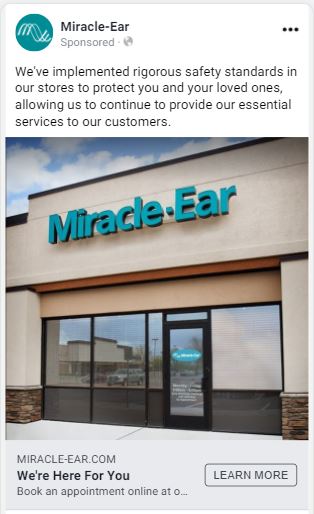How Miracle-Ear used conversational AI to reach customers during a pandemic
Nobody can plan for a year like 2020, but having the right foundational systems in place made all the difference for Amplifon, parent company of Miracle-Ear.
Nobody can plan for a year like 2020, but having the right foundational systems in place made all the difference for Amplifon, parent company of Miracle-Ear.
Among the many challenges and setbacks that businesses face from COVID-19, communicating with customers remains at the very top. This is particularly true for large franchises with locations distributed across multiple states, each facing significantly different obstacles and experiences. I recently spoke with Nataly Huff, the Director of Digital Marketing for Amplifon (parent company of Miracle-Ear) to learn how Miracle-Ear tackled the problem of managing call tracking data across their many physical locations. With 1500 locations distributed across the US, Miracle-Ear needed a way to analyze caller data at a granular level.
To address this challenge, they used Invoca, an AI-powered call tracking platform, which analyzes caller data at scale. Among other things, Invoca enabled Huff’s team to determine which states had stores open and where to allocate marketing spend to help drive foot traffic to their stores.
Huff has been with Amplifon for over four years. During that time, Amplifon’s seen significant growth to the maturity of their digital marketing strategy. This put them in a much more agile position when COVID-19 interrupted business-as-usual for many of their Miracle-Ear stores.
“In September 2019, we’d undergone a significant transformation of our digital marketing ecosystem,” says Huff. “By the end of that year we were already seeing substantial benefits from the foundational work we had done. Then COVID happened.”
In addition to each state and county having different regulatory requirements around the virus, the consumer sentiment was vastly different across geographic areas.
As a health care provider, Amplifon had to comply with local regulations, but they also needed to make sure they were there for their customers when they had hearing health needs.
“We needed an incredibly intentional and intelligent approach to how, when, and where we adjusted our messaging and our dollars,” explains Huff. “This is why having the granular integrated data at scale made all the difference with our digital transformation. We’d built an infrastructure that integrated our call outcomes into our platforms through AI conversational analysis signals.”
When the pandemic hit, Amplifon could see which campaigns, channels, and regions were driving new business versus driving calls to reschedule existing appointments.
Invoca’s data was integrated into Amplifon’s business intelligence systems, enabling them to understand down-funnel performance of their channels and campaigns.
Explains Huff, “During the initial stages of COVID-19, it was incredibly valuable to understand where people were actually showing up for their booked appointments versus just scheduling them. When we paired that with a COVID signal, regulatory requirements across the states, and Google retail mobility data, we achieved a detailed picture of consumer confidence and intent across the entire country.”
Amplifon was already using data to help inform their marketing strategies. After COVID-19, it was extremely important that they remain consistently sensitive to the needs of their customers.
This included ensuring hey had continued access to their critical hearing health needs, reinforcing the safety protocols they had in place, and ensuring they could rely on their hearing to stay connected to other people.
 Miracle-Ear ad whose messaging focuses on safety—Source: Amplifon
Miracle-Ear ad whose messaging focuses on safety—Source: Amplifon
“We adjusted our marketing based on regional regulations and consumer confidence to make sure that supporting our customers was always at the front and center,” says Huff.
Amplifon uses Invoca as the centerpiece for their data-driven approach. It connects their digital tools with their offline tools. While the overarching goal was to achieve data granularity and depth, the integration of all data is what allowed Amplifon to drive business growth.
“The data we capture with Invoca integrates into BI for automated reporting, all the way down to net revenue,” says Huff.
Amplifon uses the offline data to develop signals in Invoca that they integrate into digital marketing tools. They send user-level call outcome signals directly into Adobe, Google, and Facebook. They can then use those algorithms to drive campaign efficiency and effectiveness.
When data pointed to conscious consumer intent, Amplifon shifted their messaging to focus on supporting and being there for customers, letting them know they could still get the help they needed it.
Once they started seeing recovery to moderate consumer confidence, they shifted the messaging to focus on safe store practices, the importance of maintaining connections with loved ones, and how healthy hearing can help with that.
“In general, between the consumer sentiment recovery and decreased inventory pressure, we were able to maintain our overall marketing investment and drive business, while making sure that the right message got to that right person at the right time.”